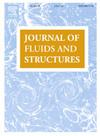热环境下输送层流的纳米复合材料微管的非线性自由振动:采用不变流形方法
IF 3.4
2区 工程技术
Q1 ENGINEERING, MECHANICAL
引用次数: 0
摘要
本研究首次对石墨烯片复合微管(GRC微管)在热环境下输送层流的自由振动进行了深入研究,为设计师和工程师提供了宝贵的洞察力。本文在欧拉-伯努利梁理论、修正的耦合应力理论(MCST)、von-Karman非线性应变关系和修正的Halpin-Tsai关系框架下建立了控制方程。利用不变流形过程,将陀螺耦合的两自由度离散控制方程有效地简化为一个具有惯性非线性的非线性控制方程。利用多尺度法(MMS)揭示了非线性固有频率及其伴随的非线性常数。强调了当GRC微管受到热介质作用时,层叠对承载层流的GRC微管振动行为的贡献是显著突出的。研究发现,虽然FGV GRC微管的基本线性固有频率较大,但在低温下,UD GRC微管在细微管中具有最大的线性固有频率。结果表明,GRC微管第一模态的硬化行为在小尺度因素下得到缓解,在流型效应下得到强化。综上所述,施加这两种因素可减轻第一模态硬化行为。本文章由计算机程序翻译,如有差异,请以英文原文为准。

Nonlinear free vibrations of a nanocomposite micropipes conveying laminar flow subjected to thermal ambient: Employing invariant manifold approach
This research presents, for the first time, essential insights into the free vibrations of a composite micropipe enriched by means of graphene sheets (a GRC micropipe) conveying laminar flow subjected to a thermal ambient, preparing precious discernment for designers and engineers. The study develops the governing equations in the framework of the Euler–Bernoulli beam theory, the modified couple stress theory (MCST), von-Karman nonlinear relations for strains, and revised Halpin–Tsai relationships. Taking the advantage of invariant manifold procedure the two-degrees-of-freedom (DOFs) discretized governing equations, coupled gyroscopically, are reduced efficiently to one nonlinear governing equation with inertial nonlinearity that coping with it is considerably simpler. Leveraging the method of multiple scales (MMS) the nonlinear natural frequency, along with the accompanying nonlinearity constant is disclosed. It is underscored that the contribution of layer stacking on the vibrational behavior of GRC micropipes carrying laminar flow is substantially highlighted when the GRC micropipe is subjected to a thermal medium. It is observed that although it is expected to have a larger fundamental linear natural frequency for an FGV GRC micropie, at low temperatures UD GRC micropipe has the largest one for thin micropipes. It is shown that the hardening behavior of the first mode of the GRC micropipe is alleviated regarding the small scale factor while it is intensified regarding the flow profile effect. In sum imposing both factors relieves the first mode hardening behavior.
求助全文
通过发布文献求助,成功后即可免费获取论文全文。
去求助
来源期刊

Journal of Fluids and Structures
工程技术-工程:机械
CiteScore
6.90
自引率
8.30%
发文量
173
审稿时长
65 days
期刊介绍:
The Journal of Fluids and Structures serves as a focal point and a forum for the exchange of ideas, for the many kinds of specialists and practitioners concerned with fluid–structure interactions and the dynamics of systems related thereto, in any field. One of its aims is to foster the cross–fertilization of ideas, methods and techniques in the various disciplines involved.
The journal publishes papers that present original and significant contributions on all aspects of the mechanical interactions between fluids and solids, regardless of scale.
 求助内容:
求助内容: 应助结果提醒方式:
应助结果提醒方式:


